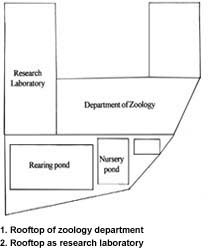
Vol. 2
No.
4
August 2000
|

Water
harvesting at kinetic engineering
Water requirements is one of the key issues faced by most industries.
One industrial group has taken the initiative in water management through water harvesting
and recycling is the Kinetic group at Koregaon Bhima in Pune district of Maharashtra.
Rainwater is collected from the rooftops of the factory buildings and recharged into
two service dugwells. The rainwater thus recoups the groundwater level, instead of
draining out through the stormwater drains. Water collected from these rooftops of 10,000
sq m amounts to approximately 30,000 litres per day. The total daily water requirement of
the plant is 45,000 litres. Since water available from these wells is intrinsically hard,
it is processed in the water softening plant before use. Groundwater recharging with
rainwater is expected to reduce the hardness of the groundwater to at least some extent
over a period of 4-5 years.
Apart from water harvesting, the company is also trying its hand at water recycling.
All the non-industrial and industrial wastewater is collected in a septic tank from where
it is taken to the effluent treatment plant (ETP) for treatment. Treated water is being
used for drip irrigation and sprinkler system in the lawns and gardens and for watering
teak plantations. Further, measures are being aimed at using water in toilets.
Another step taken in conservation of water is the laying of water lines above ground
level. This ensures the immediate detection of leakage. Moreover corrosion of galvanized
iron(GI) and mild steel (MS) water pipes is reduced drastically.
The various measures adopted for water harvesting fulfills a large percentage of the
water requirement of the factory. However some added measures for the future, such as
treatment of wellwater and effluent water, will ensure that the entire water requirement
of the factory is met by harvested and recycled water alone.
For further information:
A V Chitale, Kinetic Engineering Ltd,
D1 Block, Plot No 18/2 MIDC,
Chichwad, Pune
Tel: 774301
Email: kel@vsnl.com |

Preachers become practitioners
 |
| Rearing and Nursery pond |
Inspired by the concept of rainwater harvesting ‘Catch water where
it falls’ of the Centre for Science and Environment, New Delhi, Ram Malu, developed a
system for his institute to meet its regular water requirements. He is reader and head,
department of zoology of R A College, Washim in Maharashtra.
R A College, Washim is one of the oldest educational institutions in the Vidarbha
region in Maharashtra. Postgraduate department of zoology in this institute is conducting
a UGC-sponsored vocational course on industrial fish and fisheries. For their academic
requirements they have three fish tanks in the their premises: a nursery pond (9m x 5m x
1.5 m), a rearing pond (18m x 9m x 2m) and a plankton culture tank (5m x 3m x 1m), to
conduct aquaculture experiments.
Due to depleting groundwater resources in this region, the institute found it difficult
to fill their tanks regularly. Many of the borewells in this region are totally dry and
the college has only one borewell to meet its water requirements. The institute had spent
Rs. 15,000 for filling the above said tanks in January 1998 when these tanks were first
constructed. In spite of the fact that this district has 1,000 mm of rainfall for a period
of four months from 15th of June to 15th of October, there is an existing water crisis. In
order to overcome the problem Dr Ram Malu installed water harvesting mechanism to cope
with their requirements.
Installing the rooftop water harvesting launched the initiative in the university. The
rooftop water harvesting system for aquaculture tanks includes the roof top surface of the
department (area 549 sq m, four PVC pipelines and three concrete-lined fish tanks, and a
system to divert the excess water to drainage system. Water from the roof top surface of
zoology department and research laboratory (surface area of 294 sq m and 255 sq m
respectively) is directed towards the PVC pipe lines by maintaining the surface slope. The
harvested water is carried to three fish tanks through PVC pipes. The water holding
capacity of nursery tank, rearing tank and plankton culture tank is 67.5 cubic meters
(cum) 3,288 cum and 15 cum respectively. Thus the quantity of harvested water is more than
3.70 lakh litres.
The cost of complete installation was only Rs 3,500. This resulted into a net saving of
more than Rs 15,000 per year. Further, net profit of Rs 5,000 could be earned from sale of
food and the ornamental fishes reared in these tanks. This is thus economically viable.
This experiment of water harvesting conclusively proved the soundness of the concept
’Catch water where it falls’. The quality of the harvested water is suitable for
aquaculture.
 |
 |
| Rooftop water harvesting
system |
| Salient features of the system:
The water harvested has a special advantage
with respect to aquaculture as it is free from pollution, predatory animals and aquatic
weeds:
 Cost of water harvesting system including cost of material is
only Rs 3,500, which is less than refilling the tanks using groundwater; Cost of water harvesting system including cost of material is
only Rs 3,500, which is less than refilling the tanks using groundwater;
 No additional construction is
required; No additional construction is
required;
 Special equipment and trained
personnel are not required to operate the system, and, Special equipment and trained
personnel are not required to operate the system, and,
 Innumerable educational
institutions can undertake such steps to meet their water demands for aquaculture
experiments, college garden and tree plantation. Innumerable educational
institutions can undertake such steps to meet their water demands for aquaculture
experiments, college garden and tree plantation.
For further information:
Dr Ram Malu
Rajasthan A Arts, Mithulalji Kacholiya,
Commerce and Satyanarayan R Rathi
Science Mahavidyalaya,
Washim District, Maharashtra |
|